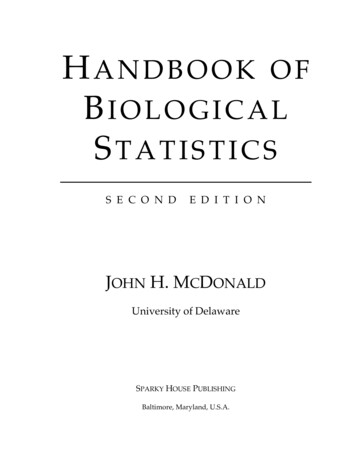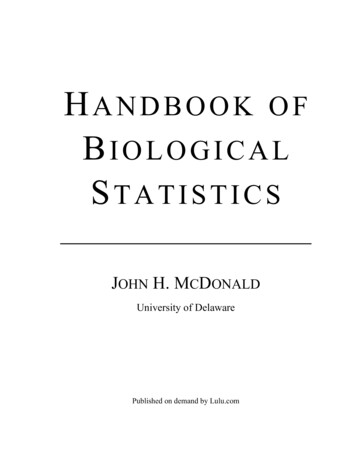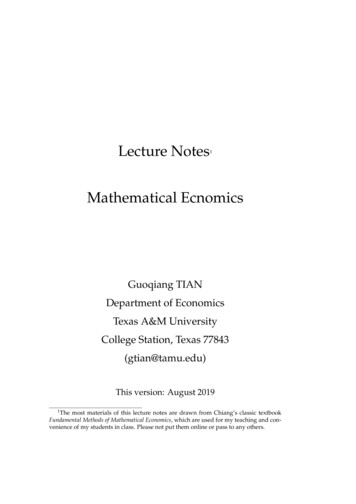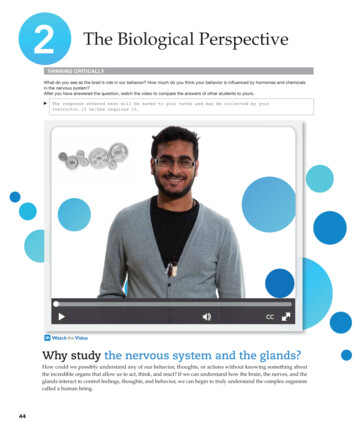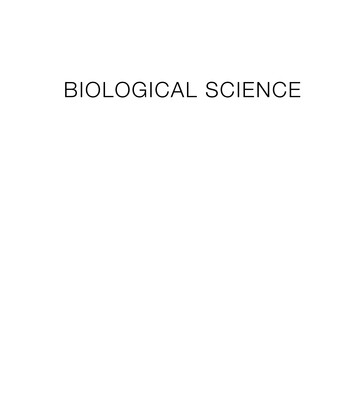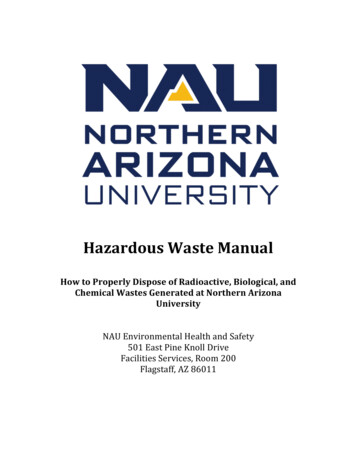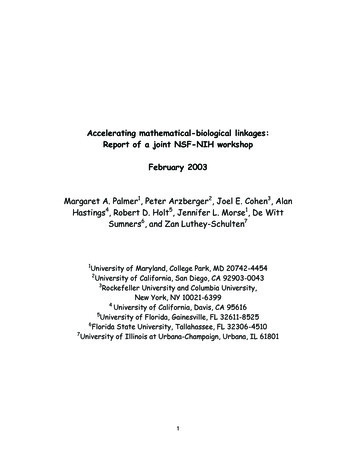
Transcription
Accelerating mathematical-biological linkages:Report of a joint NSF-NIH workshopFebruary 2003Margaret A. Palmer1, Peter Arzberger2, Joel E. Cohen3, AlanHastings4, Robert D. Holt5, Jennifer L. Morse1, De WittSumners6, and Zan Luthey-Schulten71University of Maryland, College Park, MD 20742-44542University of California, San Diego, CA 92903-00433Rockefeller University and Columbia University,New York, NY 10021-63994University of California, Davis, CA 956165University of Florida, Gainesville, FL 32611-85256Florida State University, Tallahassee, FL 32306-45107University of Illinois at Urbana-Champaign, Urbana, IL 618011
2
Accelerating mathematical-biological linkages:Report of a joint NSF-NIH workshopheld 12-13 February 2003The workshop was supported by grants fromthe National Science Foundationandthe National Institutes of Health.For citation purposes, please use: Palmer, M.A., P. Arzberger, J.E.Cohen, A. Hastings, R.D. Holt, J.L. Morse, D. Sumners, and Z. LutheySchulten. 2003. Accelerating mathematical-biological linkages. Report ofa joint NSF-NIH workshop held February 12 – 13, 2003 at the NationalInstitutes of Health. Bethesda, MD.This document is available in electronic eport.pdf3
4
Table of ContentsExecutive Summary and Recommendations . 6Motivation for Workshop . . . . 9Workshop Purpose and Organization . . 10Day 1: Symposium . . . 10Day 2: Working groups. . . . 13Institutional Action Items . . . 13Education and Training Action Items . 19Strengthening Ties Among Researchers Action Items . 26Closing Comments: Time to Act . . 30References . . . 33Appendix I: Registered Participants . 35Appendix II: Article in Science Highlighting the Event . 435
Executive Summary and RecommendationsComplex scientific questions are increasingly being addressed throughinterdisciplinary approaches. Biology and mathematics have historicallybenefited from exchange and collaboration, and they lend themselves tofurther integration and synergy today. New advances in mathematics cangrow from addressing the complexities of biological phenomena. In turn,fundamental and emerging biological problems can be better understoodand predicted with the aid of new mathematical, computational, andmodeling tools and theories. The time is ripe for accelerating progress inunderstanding and predicting important biological phenomena by usingexisting mathematical tools, by developing new mathematical approaches,and most importantly by forging new partnerships betweenmathematicians and biologists to investigate tough problems.The joint NSF-NIH workshop, “Accelerating mathematical-biologicallinkages,” was held in February 2003 to highlight the opportunities andintellectual challenges present at the mathematics-biology interface, andto challenge the institutional, cultural, and educational barriers to theseessential and fruitful partnerships.The symposium at NIH’s Natcher Auditorium featured a plenary addressby Dr. Joel E. Cohen and explored cutting-edge mathematical-biologicalwork in three areas: conservation biology, cell structure and function, andbioinformatics and computational problems. This symposium highlightedthe wealth of opportunities available at the math-biology interface, theneed for mathematics in solving complex biological problems, and theenthusiasm of researchers from many disciplines to engage in this type ofwork.Participants in the ensuing half-day workshop joined one of three workinggroups: Institutional Issues, Education and Training, and StrengtheningTies among the Researchers. Each group was charged with developingand articulating critical actions needed to enhance the math-bio linkage.The rapporteur from each group compiled the emergent ideas of thediscussion and guided the development of action items. The threeworking groups represented areas in which bold initiatives and changecould pave the way for new opportunities and results at the math-biologyinterface. Many ideas were discussed and many recommendations made;some of the recommendations are directed at NSF and NIH while manyothers are directed at scientists and mathematicians or at academic andresearch bodies.6
Institutional Issues Group RecommendationsInstitutional Action Item 1: Two large scale initiatives should beaggressively pursued by both NIH and NSF: 1) large competition(s) tofoster new biological breakthroughs through high impact research madepossible by mathematical applications and theory; 2) the creation of anational research center for Biological Research Interfacing withMathematics, to review and fund proposals that would bringmultidisciplinary groups of scientists from around the world to the center towork together on major unsolved issues in both fundamental and appliedarenas.Institutional Action Item 2: Establish and provide sustained support for afederated network of data resources for biological information from thegenomic and proteomic levels through organismal organization and up toenvironmental information to better enable biomedical and biological multiscale integrative research. This initiative should build on existingcommunity databases and resources to take advantage of investmentsand research in cyber-infrastructure, to create an integrated (butdistributed) set of resource for the community.Institutional Action Item 3: Formalize publishing standards for modeldevelopment to improve the quality and level of access to data andmodels.Institutional Action Item 4: Create a federation to coordinate Math/Biologysocieties, to provide a united voice for major funding initiatives, forenhancing cross-disciplinary interaction, and for interdisciplinaryundergraduate and graduate education.Institutional Action Item 5: Examine existing programs within NSF andNIH, and assess what changes could be readily achieved to improveresearch and education at the math-bio interface. Develop a subprogramwithin IGERT, focused on the issue of math-bio linkage training.Education and Training Group RecommendationsEducation Action Item 1: Create new interdisciplinary postdoctoralprograms at the interface between mathematics/statistics/computerscience and biology/biomedicine.7
Education Action Item 2: Convene a high level (e.g., NAS) workshop thatattracts department chairs from biology, math, computer science andstatistics departments to identify means to promote cross-disciplinarycurricula and training appropriate for the kind of biological questions beingexplored, including support for double degrees in math and biology.Recommended for Fall 2003 (urgent).Education Action Item 3: Create joint faculty positions at the interfacebetween mathematics/statistics and biology/biomedical sciences, withappropriate mentoring and clear expectations for interdisciplinary work.Education Action Item 4: Develop summer math/bio programs for highschool math, computer science, and biology teachers and their students,to introduce them together to the interface between math and biology.Education Action Item 5:math/biology interface.Develop K-12 educational material for theEducation Action Item 6: Develop a central website and a listserv todisseminate information on research and training opportunities at themath/biology interface.Strengthening Ties among the Researchers Group RecommendationsResearchers Action Item 1: Compile a list of the top ten most challengingand promising areas in mathematical biology, including modeling ofmultilevel systems, integrating probabilistic theories, data mining andinference, and computational tools.Researchers Action Item 2: Organize a national meeting in WashingtonD.C. on Mathematical Biology, to showcase (over 3 – 5 days) successeswhere mathematics and computations have helped solve importantproblems in medicine and to motivate new directions and opportunities onall levels of biology from cells to organs to ecology to the biosphere.Researchers Action Item 3: Develop a series of advanced ‘educational’workshops for mathematicians and biologists to learn about the otherdiscipline, to facilitate communication and interaction.Researchers Action Item 4: Strengthen the publication ties betweenmathematics and biology, through merged databases online journalaccess, and foster the publication of interdisciplinary papers.8
Motivation for the WorkshopComplex scientific questions are increasingly being addressed throughinterdisciplinary approaches.Interdisciplinary collaboration allowsscientists to effectively apply a wider array of tools and theories in solvingproblems that bridge traditional disciplinary boundaries. Each discipline isenriched by these collaborations: new theories, new analytical tools, andnew frontiers are developed.Biology and mathematics are two disciplines that have historicallybenefited from exchange and collaboration and that lend themselves tofurther integration and synergy today. New mathematical approaches,aided by new computational and modeling tools, can be applied tofundamental biological problems (Hastings and Palmer 2003).The time is ripe for accelerating progress in understanding and predictingimportant biological phenomena by using existing mathematical tools, bydeveloping new mathematical approaches, but most importantly by forgingnew partnerships between mathematicians and biologists to investigatetough problems. The burgeoning base of theoretical and empirical work,made possible by new methods and technologies, in particular theadvances in information science given rise to cyberinfrastructure (Aktins etal 2003; Wooley et al 2003), is providing the impetus to reach robustanswers to the major integrative biological challenges faced by oursociety. Meeting those challenges will require new efforts to trainmathematicians and biologists to work at the interface of two disciplinesand/or work collaboratively much more frequently (Levin et al. 1992, Levinet al. 1997, and Hastings et al. 2002).We need a new generation of empiricists with stronger quantitative skillsand theoreticians with a detailed understanding of the empirical structureof biological processes. It is very difficult for a single scientist – biologistor mathematician -- to develop the depth needed to address the questionsat the frontiers. Instead, we must foster increased research collaborationamong biologists and integrative biologists who are trained to understandthe language of one another. The mathematical and statistical constructsused in much biological research come mostly from linear theory. Incontrast, many biological processes are governed by non-linear dynamics,threshold effects, and more complex relational structures. Both thebiological and mathematical sciences will benefit from additionalcollaboration (Hastings et al. 2002).9
Workshop Purpose and OrganizationThe purpose of this workshop was to highlight the opportunities andintellectual challenges present at the math-bio interface, and to challengethe institutional, cultural, and educational barriers to these essential andfruitful partnerships. The workshop consisted of a day-long symposium(February 12) followed by a half day (February 13) in which small workinggroups identified key needs to move mathematical-biological linkagesforward. Linkages are defined broadly to include collaborations amongmathematicians and biologists, educational and training (at all stages fromgraduate school to mid-career scientists) opportunities, new researchinitiatives, society and small group projects as well as other activities.More than 170 biologists, engineers, mathematicians, computer scientists,physicians, educators, and administrators attended the symposium on“Accelerating Mathematical-Biological Linkages,” held on February 12,2003, at the Natcher Auditorium on the National Institutes of Healthcampus in Bethesda, Maryland (Appendix 1). More than 60 attendeesparticipated in the ensuing half-day workshop by joining one of threeworking groups:Education and Training, Institutional Action, andCollaborations. Each group brainstormed throughout the morning todevelop and articulate critical actions needed to enhance the math-biolinkage. Reports were then made to all participants and discussionfollowed.Day 1: SymposiumThe auditorium was filled to capacity – registration closed at 150 but therewere an additional 20 – 25 attendees. The symposium was convened byDr. Margaret Palmer, of the University of Maryland, who opened themeeting by highlighting the urgent need for accelerated linkages betweenbiologists and mathematicians. She then introduced the rest of theevent’s organizing committee (Dr. Sam Scheiner and Dr. Mike Steuerwaltof the National Science Foundation; Dr. Jim Cassatt, Dr. Mike Marron, andDr. John Whitmarsh, of the National Institutes of Health).Dr. Mary Clutter, Assistant Director of the National Science Foundation,offered her most enthusiastic support of the goals of the conference anddiscussed several areas in the life sciences in which exciting andfundamentally quantitative opportunities exist. The areas she highlightedincluded topics from the environmental sciences as well as genomics and10
proteomics. Dr. Clutter called for a re-evaluation of cultural, educational,and disciplinary barriers that impede communication and interactionbetween disciplines.Dr. Mike Gottesman, Deputy Director of Intramural Research at theNational Institutes of Health, followed by underlining the importance ofmathematics in the development of ecological and biological theories, andemphasized that in the future, biological research would likely require aquantitative component to be relevant. He expressed the strong supportof the National Institutes of Health leadership for enhancing research atthe mathematical-biological interface.Dr. Joel Cohen, of Rockefeller and Columbia Universities, presented hiskeynote address, "Mathematics Is Biology's Next Microscope, Only Better;Biology is Mathematics' Next Physics, Only Better." Drawing fromDescartes, Darwin, Harvey, and many other pivotal figures, Dr. Cohenprovided a compelling overview of key historical contributions, bothtechnical and conceptual, by which mathematics can contribute to theadvancement of biological knowledge and theory. He also discussed howcomplex biological problems, from molecular to global-level processes,have provided new topics for mathematical research and development.By summarizing both new opportunities for and potential impediments tothese math-bio collaborations, Dr. Cohen generated enthusiasm andsupport for this burgeoning field of science.Following the plenary address by Dr. Cohen, the symposium turned toexploring mathematical-biological work in three areas: conservationbiology, cell structure and function, and bioinformatics and computationalproblems. These areas were not meant to be exhaustive of the manybiological areas that are ripe for quantitative work, but simply meant to beillustrative.In the conservation biology session, Dr. Michael Neubert, of Woods HoleOceanographic Institution, discussed his experience as an appliedmathematician collaborating with a plant ecologist, and talked about hisscientific findings in applying integro-difference equations to the dispersalof an invasive shrub species. His insight into the cultural and disciplinarydifferences that arose during the course of the work was particularlyvaluable. Dr. Leah Gerber, of Arizona State University, spoke about herwork as an applied population biologist; she integrates cutting-edgeepidemiological models into population viability analysis for managementof threatened populations and to determine extinction risk. Her talk alsodemonstrated the importance of complex mathematical models in defining11
uncertainties in different conservation scenarios,understanding sea otter populations in California.particularlyinThe afternoon session began with presentations on cell structure andfunction. Dr. Alex Mogilner, of the University of California, Davispresented, “Mathematics and a force balance model to understand mitoticspindles,” in which he integrated physics approaches and mathematicalmodeling to explain the role of microtubules in generating key forces thatpropel the mechanism of cell division. He reported successful results frominterdisciplinary training in his Cell and Computational Biology laboratory,which links theory and experimentation, and brings togethermathematicians, cell biologists, and biophysicists. Dr. Sharon Lubkin, ofNorth Carolina State University, discussed her work in developmentalbiology, which uses mathematical models and experiments to understandand predict branching structures in tissues. Her modeling work is alsoperformed in collaboration with experimental biologists.The final session of the symposium highlighted research in bioinformaticsand computational problems. Dr. Chuck Delwiche, of the University ofMaryland, spoke about his applications of bioinformatics to the study ofgene transfers into plastid genomes in dinoflagellates. His lab usesmethods in molecular systematics and genomics, including cDNAscreening and selective sequencing of genomic DNA, to understand thephylogenetic history of dinoflagellates. Dr. Monica Hurdal, of Florida StateUniversity, rounded out the afternoon by discussing a medical perspectiveon the math-bio interface in her presentation, “Mapping the Human Brainwith Mathematical and Computational Modeling.” She is involved in theHuman Brain Project and is using MRI (magnetic resonance imaging)scans and EEG (electroencephalography) data to understand humanbrain functions. Innovative approaches to computer modeling andclassical geometric theories are both key aspects of her work.The day’s talks were summed up by rapporteurs for each session: Drs.Bob Holt (University of Florida), Zan Luthey-Schulten (University ofIllinois), and De Witt Sumners (Florida State University). A lively opendiscussion with audience participation was then led by the hosts andrapporteurs. Members of the audience actively exchanged ideas duringthe discussion, asking questions and voicing opinions on a wide range ofissues including curriculum development, national security, collaborationand data sharing, training of graduates and undergraduates, and how tobest bring about the cultural and disciplinary changes that stand in theway of this new initiative.12
Day 2: Working groups and recommendationsThe second day was quite informal, beginning with a charge toparticipants to develop break-out groups to focus on one of three areas, togenerate ideas that could lead to concrete programs or initiatives:Education and Training, Institutional Issues, and Research CollaborationIssues. Each group was led by a rapporteur who compiled the emergentideas of the discussion and guided the development of action items.Institutional Action Items(Rapporteur: Bob Holt)Institutional Action Item 1: Joint NSF-NIH Initiatives1a. Concept:Develop a plan for major programs deservingsubstantial new funding, specifically to target new biologicalbreakthroughs made possible by mathematical applications andtheory.This initiative would move well beyond the currentNSF/NIGMS Initiative in Mathematical Biology to a much broaderprograms jointly directed by NIH and NSF.Rationale: There is an urgent need to solve a proliferating array of major,global scale problems, ranging from ecological and evolutionarydimensions of disease transmission and spread, to analyses of disruptionsof neurological mechanisms and repair due to environmental factors, tothe management of enormous, burgeoning genomic databases in anefficient fashion. Addressing these problems is difficult (if not impossible)without the application of sophisticated theoretical, mathematical, andcomputational approaches.In principle, mathematical, computational, and statistical tools and theory(both existing and created) can be brought to bear in ways never beforepossible, and major breakthroughs are to be expected in dealing withthese crucial problems. But this requires substantial societal support instrengthening ties between the communities of the mathematical sciencesand biology, well beyond that provided by existing governmentalprograms.13
Educating a new generation of scientists specifically focused on thisinterface is essential, and requires substantial support. Joint sponsorshipby NSF and NIH of a major initiative funding research and education inthis area would send a powerful message about the importance andurgency of this mission. At a pragmatic level, a joint initiative wouldgreatly enhance the synergistic and complementary kinds of sciencetypically funded by NSF and NIH respectively, and help cut across thesuture zones currently separating the relevant disciplines.Proposed Plan: The need for funding for work at the math-bio interface isso urgent that we recommend a special joint NSF-NIH initiative that isextremely large in scope (hundreds of millions of dollars). The planningfor such an initiative should from the outset involve both agencies.If such an initiative were successful, it would specifically broaden thescope of the current NSF/NIGMS Math-Bio study section to includerepresentation/funding from: NIBIB (Bioimaging/Biotech), NHGRI (HumanGenome Res. Inst.), NCRR (research resources), NIAID (infectiousdiseases) as well as many programs at NSF. So rather than an ad hocspecial study section, one could envisage a permanent chartered studysection. This new program should be explicitly charged with using asubstantial portion of their funds for high-risk (but potentially high impact)research.1b. Concept: Create a high visibility, national center specificallydevoted to research at the interface between mathematics andbiology. It should provide funding and logistical support for thenational community of biologists and mathematicians (i.e., thisshould not be a center that primarily serves a few institutions ortopical areas). As a means toward this end, workshops should beheld to call for proposals for such a center.Rationale: Several existing centers provide models of highly effectivemechanisms for fostering novel interdisciplinary approaches. Withinecology, the National Center for Ecological Analysis and Synthesis(NCEAS, University of California, Santa Barbara) has provided anexemplary service, bringing together groups of scientists who historicallyhad never worked together, so as to address major unsolved issues inboth fundamental and applied arenas. Many of the synthetic activitiesinitiated at NCEAS have continued in ongoing collaborations, grantproposals and the like; in effect, NCEAS has created a large and growingweb of interlinked research activity that is much larger in social scope than14
was previously possible. In like manner, a center specifically focused oncutting across the interface between mathematics and biology could act asa powerful catalyst for research and educational efforts.Proposed Plan: National funding by a consortium of agencies (e.g., NSF,NIH) will be required for the creation of a center. However, for a ‘thinktank’ to work, there needs to be a mechanism ensuring the whole-heartedsupport of the concerned communities. A “bottom-up” approach is to havea series of workshops aimed specifically at honing the mission andstructure of a research center. A concrete product of these workshopswould be a statement of the content of a call for proposals fromuniversities, existing research institutes, or consortia for housing a Centerin Mathematical/Quantitative/ Computational/Theoretical Biology.Institutional Action Item 2: DatabasesConcept: Work to establish integrated data resources for biologicalinformation at levels building up from the genomic and proteomiclevels, through functional aspects of organismal functioning, tohigher levels of organization (including environmental information),building upon new tools and technologies that are creating thecyber-infrastructure. Such federated resources should be developedwith guaranteed support that permits it to integrate and makeaccessible data drawn from scientific efforts around the globe. Themulti-agency commitment should be such that investigators can beconfident of the long-range durability of the resources.Rationale:Many of the next generation’s advances in biologicalunderstanding are likely to involve the integration of vast bodies ofinformation from many levels of biological organization, includinginformation defining the context of environmental drivers of organismalfunctioning. The existence of accessible databases can create theopportunity for unexpected, exciting developments in scientificunderstanding. For instance, gene sequencing databases have permittedsystematic evolutionary biologists to revolutionize understanding of thehistory of life for many organisms.The development, application, and evolution of sophisticatedmathematical and statistical models of biological systems would be greatlyfacilitated were investigators able to draw on a reliable, carefullystructured database spanning the biological sciences. However, creatingand managing such a synthetic data base system, covering not onlyhuman genomics, but the functional information on all aspects of15
organismal functioning (the ‘physiome’ and ‘niche’ of each species understudy) across the diversity of life is an immense, long-range effort.One of the great challenges is that the rapid development of technologyinexorably makes a database created today into tomorrow’s potentialelectronic white elephant. Broad national commitment would ensure thelong-term viability and usability of these resources. Furthermore, modelsare being built now by communities that take advantage of the new cyberinfrastructure tools and reflect the need to have curation of the data doneby experts at local levels. One such example is the BiomedicalInformatics Research Network (BIRN), funded by National Centers forResearch Resources (see http://www.nbirn.net).Proposed Plan: There are many agencies currently involved in issues ofdatabase creation and management. An initial effort should be made toencourage natural moves to federate these already existing, ongoingactivities. This could be achieved by organizing workshops includingNLM, NSF, NIH, ODD, DOE, the Smithsonian, NPS, NASA, EPA, and soforth. These workshops should incorporate both agency representativesand working scientists.There are many crucial issues which could be addressed in theseworkshops, including metadata standards, national security concerns, theproprietary ‘ownership’ of data, problems of validation and accessibility,and interagency cooperation. A long-term goal of these workshops andthis initiative in general might be to make a proposal to Congress thatwould provide funding to coordinate the establishment of a sustainedfederation of strategic biological data in data resources and data bases, tobetter enable biomedical and biological multi-scale integrative research.This initiative should build on existing community databases andresources to take advantage of investments and research in cyberinfrastructure, to create an integrated resource for the community.Institutional Action Item 3: Publishing StandardsConcept: Call for the formalization of publishing standards byjournals regarding model structures and specifications, and developmechanisms for the maintenance of specified models on electronicdatabases. The publishing standards should be complete, includingequations, all parameters and units, initial and boundary conditions,and the information sources used to supply the data for parameterspecification and validation.16
Rationale: It is difficult for investigators at present to rapidly compare andsynthesize published models. This slows progress in the field. Asystematic, formalized specification of model structures and informationsources could greatly facilitate integration among models developed bydifferent investigators, particularly working at different levels of biologicalorganization.Proposed Plan: The first step would be to have a workshop involvingrepresentatives of the major journals and societies in the field, to identifythe major issues and plan a course of action. Prior to such a workshop,an electronic call should go out to the community, soliciting input andsuggestions. This workshop should be jointly sponsored by NSF and NIH.Institutional Action Item 4: Federation to CoordinateMathematical/Biological SocietiesConcept: Investigate the potential for a federation to coordinate andstreamline functions of the many societies interested in our subject.Rationale: Many societies are already involved in research and educationat the math-bio interface. A sampling of such societies includes theSociety for Mathematical Biology, the Theoretical Ecology section of theEcological Society of America, the 5MB Biophysical Society, ESMTB(European Society of Mathematical and Theoretical Biology, ISCB (Inti.Soc.Compo Bioi.) Japan Society, SIAM -Life Sciences, IEEE -EMBS andBMES. A federation of societies could provide a united voice for majorfunding initiatives, for instance those aimed at enhancing crossdisciplinary dimensions of undergraduate and graduate education.Afederation could also help legitimize work in this interdisciplinary field andthus provide support for young researchers.Proposed Plan: Organize a workshop at a national venue, such as theannual AAAS meeting. This could be coordinated with a symposium,focused on the math-bio interface (comparable in spirit to the recent NSFNIH workshop in Bethesda).Institutional Action Item 5: Plan to Foster Support forInterdisciplinary Work at the Institutional LevelConcept: Commission a study of universities where interdisciplinarywork thrives. This study would identify “best practices” -structural17
and administrative features that promote successful interdisciplinaryventures. This study would necessa
D.C. on Mathematical Biology, to showcase (over 3- 5 days) successes where mathematics and computations have helped solve important problems in medicine and to motivate new directions and opportunities on all levels of biology from cells to organs to ecology to the biosphere.


